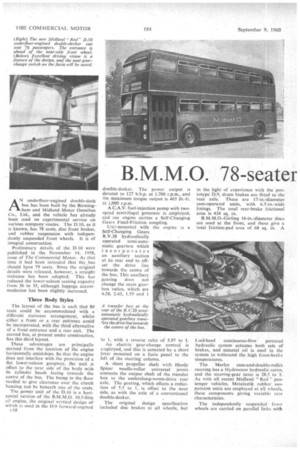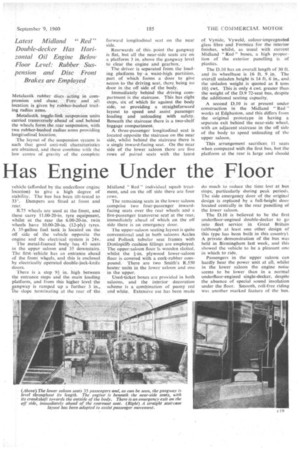B.M.M.O. 78-seater
Page 96

Page 97

If you've noticed an error in this article please click here to report it so we can fix it.
Has Engine Under the Floor
AN underfloor-engined double-deck bus has been built by the Birmingham and Midland Motor Omnibus Co., Ltd., and the vehicle has already been used on experimental service on various company routes. The D.10, as it is known, has 78 seats, disc front brakes, and rubber suspension with independently suspended front wheels. It is of integral construction.
Preliminary details of the D.10 were published in the November 14. 1958, issue of The Commercial Motor. At that time it had been intended that the_bus should have 79 seats. Since the original details were released, however, a straight staircase has been adopted. This has reduced the lower-saloon seating capacity from 36 to 35, although luggage accommodation has been slightly increased.
Three Body Styles
The layout of the bus is such that 80 seats could be accommodated with a different staircase arrangement, Whilst either a front or a rear entrance could be incorporated, with the third alternative of a front entrance and a rear exit. The second bus, at present under construction, has this third layout.
These advantages are principally derived fromthe location of the engine horizontally, amidships. So that the engine does not interfere with the provision of a flat lower-saloon gangway, the unit is offset to the near side of the body with its cylinder heads facing towards the centre of the bus. The bump in the floor needed to give clearance over the clutch housing can be beneath one of the seats.
The power unit of the D.10 is a horizontal version of the B.M.M.O. 10.5-litre oil engine, the original vertical design of which is used in the D.9 forward-engined c18 double-decker. The power output is derated to 127 b.h.p. at 1,700 r.p.m., and the maximum torque output is 465 lb.-fr. at 1,000 r.p.m.
A C.A.V. fuel-injection pump with two. speed centrifugal governor is employed, and Inc engine carries a Self-Changing Gems Fluid-Friction coupling.
Unit-mounted with the engine is a Self-Changing Gears R.V.28 hydraulically operated semi-automatic gearbox which incorporates an auxiliary section at its rear end to offset the drive line towards the centre of the bus. This auxiliary gearing does not change the main gearbox ratios, which are 4.28, 2.43, 1.59 and 1
to 1, with a reverse ratio of 5.97 to 1.
An electric gear-change control is eatployed, and this is actuated by a short lever mounted on a facia panel to the left of the steering column.
A short propeller shaft with Hardy Spicer needle-roller universal joints connects the output shaft of the transfer box to the underslung-worm-drive rear axle. The gearing, which effects a reduction of 5.5 to 1, is offset to the near side, as with the axle of a conventional double-decker.
The original design specification included disc brakes at all wheels, but in the light of experience with the prototype D.9, drum brakes are fitted to the rear axle. These are 17-its-diameter cam-operated units, with 6.5-in.-wide linings. The total rear-brake frictional area is 424 sq. in.
B.M.M.0.-Gierling 16-in.-diameter discs are used at the front, and these give a total friction-pad area of 68 sq. in. A Lockheed continuous-flow powered hydraulic system actuates both sets of brakes, and mineral oil is used in the system to withstand the high front-brake temperatures.
The Marles cam-and-double-roller steering has a Hydrosteer hydraulic servo, and the steering-gear ratio is 28.5 to I. As with all recent Midland " Red " passeneer vehicles, Metalastik rubber suspension units are employed at all wheels, these components giving variable rate characteristics.
The independently suspended front wheels are carried on parallel links with Metatastik rubber discs acting in compression and shear. " Fore am aft_ location is given by rubber-bushed trailing radius arms.
Metalastik toggle-link suspension units carried transversely ahead of aild behind the wheels form the rear suspension, with two rubber-bushed radius .arms providing longitudinal location.
The layout of the suspension system is such that good anti-roll charaeteristics are obtained, and these combine with the low centre of gravity of the complete vehicle (afforded by the underfloor engine location) to give a high degree of stability. The bus has been tilt-tested to 33°. Dampers are fitted at front and rear.
B.75 wheels are used at the front, and these carry 11.00-20-in. tyre equipment, whilst at the rear the 6.00-20-in, twin wheels have 10.00-20-in. (12-ply) tyres. A 35-gallon fuel tank is located on the off side of the vehicle opposite the engine and the electrical system is 24v.
The metal-framed body has 43 seats in the upper saloon and 35 downstairs. The first-vehicle has an entrance ahead of the front wheels, and this is enclosed by electrically operated double-jack-knife doors.
There is a step 9+ in. high between the entrance steps and the main loading platform, and from this higher level the gangway is ramped up a further 3 in., Ihe slope terminating at the rear of the forward longitudinal seat on the near side.
Rearwards of this point the gangway is flat, but all the near-side seats are on a platform 3 in. above the gangway level to clear the engine and gearbox.
The driver is separated from the loading platform by a waist-high partition, part of which forms a door to give access to the driving seat, there. being no door in, the off side of the body.
Immediately behind the driving compartment is the staircase. This has eight steps, six of which lie against the body side, so providing a straightforward layout to speed and assist passenger loading and unloading with safety. Beneath the staircase there is a two-shelf luggage compartment.
A three-passenger longitudinal scat is located opposite the staircase on the near side, whilst behind the staircase there is a single inward-facing seat. On the near side of the lower saloon there are five rows oF paired seats with the latest Midland Rest' individual squab treatment, and on the off side there are four rows.
The remaining seats in the lower saloon comprise two four-passenger inwardfacing seats over the rear wheels and a five-passenger transverse seat at the rear, immediately ahead of which on the off side there is an emergency door.
The upper-saloon seating layout is quite conventional and in both saloons Accles and Pollock tubular seat frames with Dunlopillt cushion fillings are employed. The upper-saloon floor is wooden slatted, _whilst the +-in, plywood lower-saloon floor is covered with a cork-rubber compound. There are two Smith's R.550 heater -units in the lower saloon and one in the upper.
Used-ticket boxes are provided in both saloons, and the interior decoration scheme is a combination of peony red and white. Extensive use has been made of Vynide, Vyweld, colour-impregnated glass fibre and Formica for the interior finishes, whilst, as usual with current Midland " Red " buses, a high proportion of the exterior panelling is of plastics.
The D.10 has an overall length of 30 ft. and its wheelbase is 16 ft. 9 in. The overall unladen height is 14 ft. 6 in., and.. the unladen weight is quoted as 8 tons 10+ cwt. This is only 4 cwt. greater than the weight of the D.9 72-seat bus, despite the additional seating capacity.
A second p.m is at present under construction in the Midland "Red " works at Edgbaston, and this differs from the original prototype in having a separate exit behind the near-side wheel, with an adjacent staircase in the off side of the body to speed unloading of the upper saloon.
This arrangement sacrifices 11 seats when compared with the first bus, but the platform at the rear is large and should do much to reduce the time last at bus stops; particularly during peak periods. The side emergency door of the original design is replaced by a full-height door located centrally in the rear panelling of the lower saloon.
The D.10 is believed to be the first underfloor-engined double-decker to go into fleet service in Great Britain (although at least one other design of this type has been built in this country). A private demonstration of the bus was held in Birmingham last week, and this showed the vehicle to be a pleasant one in which to ride.
Passengers in the upper saloon can hardly hear the power unit at all, whilst in the lower saloon the engine noise seems to be lower than in a normal underfloor-engined single-decker, despite the absence of special sound insulation under the floor. Smooth, roll-free riding was another marked feature of • the bus.




















































































































































